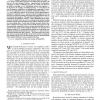78 search results - page 14 / 16 » Using PQ Trees for Comparative Genomics |
GECCO
2005
Springer
14 years 1 months ago
2005
Springer
Choosing the right representation for a problem is important. In this article we introduce a linear genetic programming approach for motif discovery in protein families, and we al...
BMCBI
2004
13 years 7 months ago
2004
Background: For the purposes of finding and aligning noncoding RNA gene- and cis-regulatory elements in multiple-genome datasets, it is useful to be able to derive multi-sequence ...
BMCBI
2008
13 years 7 months ago
2008
Background: A fundamental problem when trying to define the functional relationships between proteins is the difficulty in quantifying functional similarities, even when well-stru...
BMCBI
2007
13 years 7 months ago
2007
Background: As a consequence of the evolutionary process, data collected from related species tend to be similar. This similarity by descent can obscure subtler signals in the dat...
IJIT
2004
13 years 9 months ago
2004
Abstract-- Biological sequences from different species are called orthologs if they evolved from a sequence of a common ancestor species and they have the same biological function....


